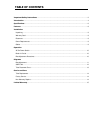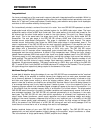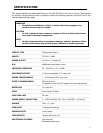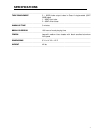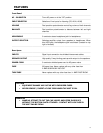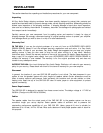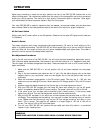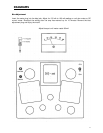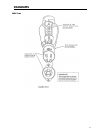
INTRODUCTION
Congratulations!
You have purchased one of the most exotic vacuum tube audio integrated amplifiers available. Within its
power range, the CAD 300 SEI integrated amplifier offers the most realistic sound reproduction one could
desire for a “high-end” home audio system. Careful design, parts selection and proper circuit topologies
contribute to the incredible reliability and enjoyment.
For the technically minded, a review of the circuit is in order. Your new CAD 300 SEI operates in a class A
single-ended mode utilizing an auto bias (cathode) system for the 300B triode output tubes. The input
preamplifier section utilizes a 6SN7 dual triode tube. One triode section of this dual tube is used for the
left channel and the other triode section is used for the right channel. This circuit is a Class A voltage
gain circuit. This is the same basic first stage input circuit utilized in the Cary Audio model SLP 98
preamplifier. The next gain stage in the CAD 300 SEI utilizes a 6SN7 dual triode wired in a series
constant-current plate-loaded configuration. This stage is duplicated for each channel. The series
constant-current configuration then drives the 300B triode output stage in single-ended, class A. The
output transformers in the CAD 300 SEI are the most important components in the amplifier and have
been specifically designed by Cary Audio for use in the CAD 300 SEI. The output transformer is an air-
gap design with a commercial continuous rating of 200% duty cycle. The CAD 300 SEI output
transformer is an E/I laminate, silicon impregnated, grain oriented steel design. The windings are wax
impregnated and the entire transformer is potted in high temperature wax. Utilizing the linear, directly
heated filament-cathode 300B triode output tube, there is no global feedback used in the CAD 300 SEI.
The power supply is a full wave center tap configuration running high voltage, high current fast switching
diode rectifiers. The rectified 450 VDC is fed to a PI-L filter network. The filter capacitor consists of two
(2) 1200 MFD and 230 Joules of energy storage. Each electrolytic capacitor is by-passed with a low
impedance .22 polystyrene capacitor. The power transformer is a 200% duty cycle rating on the CAD 300
SEI. To avoid AC hum, both the 6SN7 and 300B tube have DC voltage on the filaments. This will prevent
AC ripple voltage from capacitively being coupled to the elements in the tubes.
Additional Design Thoughts
A great deal of attention during the design of your new CAD 300 SEI was concentrated on the “overload
recovery” ability of the amplifier to instantly recover from clipping and is a much more important issue
tan is commonly believed. In the power war of amplifier manufacturers the mentality is focused on high
and then even higher power output to solve the clipping problem. When in reality, the most critical
aspect is how fast a recovery an amplifier can achieve after overload. Most of the music being listened to
in an average listening room is only requiring about 3 watts of power. It is on the transients of loud low
frequency program material that tremendous signal voltages will appear at the input of the amplifier. It is
in this situation that the overload recovery ability of an amplifier is of critical concern. The single-ended
CAD 300 SEI extols its merits in the ability to handle transients and instantaneously recover from brief or
even extended overloads. The CAD 300 SEI will overload symmetrically at any frequency in the audio
band pass. The CAD 300 SEI will also yield faithful reproduction of extremely low frequencies at full
output levels. Power transformer, power supply regulation and output transformer design and careful
shaping of the overall frequency response curve all play a very important part in the ability of the CAD
300 SEI to recover quickly when overloaded. If one were to monitor the high voltage rail voltage (385
VDC at the anode of the 300B tube) of a CAD 300 SEI during soft and loud music passages it will be
found there is no more than a volt or so change from soft to loud passages.
Another technical feature of your new CAD 300 SEI is amplifier stability. The CAD 300 SEI may be
operated with no load (without speaker) without damage to the amplifier, output transformer or tubes.
This is the hallmark of a high performance, STABLE, amplifier circuit design.
4




